That can certainly be the case, especially with softer and open grain woods. His kit is in cherry, and looks good. The pear wood should even be better, from what I've seen, having very little discernable grain in the photos. I am assuming that is why it comes at a premium compared to cherry, which I already consider a great wood for modeling and furniture.I believe the problem I am faced with in just drilling holes, with nothing in them, is the structure of the basswood itself. It just doesn’t look “clean” to me after drilling. But maybe I should stop using a head magnifier.
With cherry being harder with a tight grain I expect he gets a much better cut from the drill bit.
-

Win a Free Custom Engraved Brass Coin!!!
As a way to introduce our brass coins to the community, we will raffle off a free coin during the month of August. Follow link ABOVE for instructions for entering.
You are using an out of date browser. It may not display this or other websites correctly.
You should upgrade or use an alternative browser.
You should upgrade or use an alternative browser.
- Joined
- Dec 1, 2016
- Messages
- 6,334
- Points
- 728

we should consider actual ship building and model ship building they are 2 different things one is an artistic rendition of a ship so anything goes, out of scale, different types of material or not conforming to historical data.
here is an example of frame construction early 1800 wooden tree nails are used. Both tree nails for timbering is used and iron spikes are used so there never was a point in time where tree nails were replace with iron and copper they were used together to the end of wooden ship building. My field notes recorded the wooden pegs at 1 inch dia.
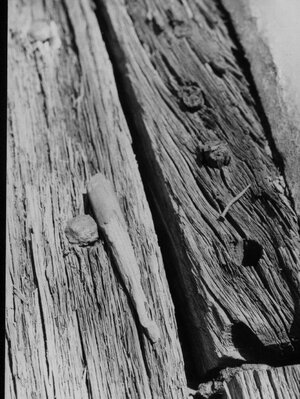
on the same wreck the planking used iron rods and clench rings
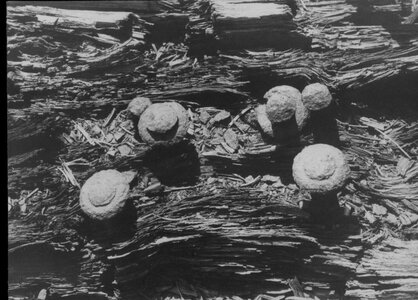
here iron spikes are used
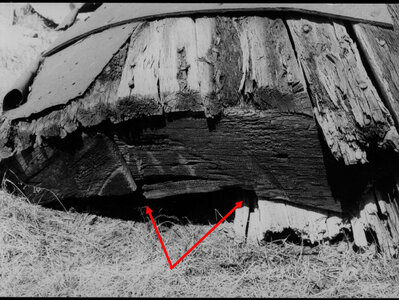
here is an example of frame construction early 1800 wooden tree nails are used. Both tree nails for timbering is used and iron spikes are used so there never was a point in time where tree nails were replace with iron and copper they were used together to the end of wooden ship building. My field notes recorded the wooden pegs at 1 inch dia.

on the same wreck the planking used iron rods and clench rings

here iron spikes are used

Last edited:
- Joined
- Dec 1, 2016
- Messages
- 6,334
- Points
- 728

while i was researching the Tecumseth i came across the use of iron rods that were split at the end, they were driven through the timber and a small wedge was used to spread the end of the rod. Like you would do at the end of a handle to hold an ax head except the iron rod was split.
- Joined
- Dec 1, 2016
- Messages
- 6,334
- Points
- 728

In Alan McGowan's book HMS Victory, Her Construction, Career and Restoration, he says "Most of the deck and outer and inner planking was attached to the beams and frame timbers by means of treenails. These were long wooden dowels made from good-quality, straight-grained, well-seasoned oak, and of round section. The treenail was dipped in tallow and driven into a drilled hole by using a pin mail. The surplus ends were cut off and caulked to bell the ends slightly and prevent withdrawal or loosening. Very few treenails are being used in the restoration work except to hold large laminates together, and these are usually made from teak."
this has been a problem for the past 30 some years in the hobby. A FACT was takes as a wide brush stroke a wooden peg was found used on a wreck so ALL ships of ALL time used wooden pegs. The Victory was one ship example built by a yard in England at a certain date so if you are not building the Victory what is found there may not apply to the model your building. Time and time again ships were burned to recover the iron so this kind of implies iron spikes were used more than wooden pegs.
but like i said are we talking artistic model building or historical facts?
this has been a problem for the past 30 some years in the hobby. A FACT was takes as a wide brush stroke a wooden peg was found used on a wreck so ALL ships of ALL time used wooden pegs. The Victory was one ship example built by a yard in England at a certain date so if you are not building the Victory what is found there may not apply to the model your building. Time and time again ships were burned to recover the iron so this kind of implies iron spikes were used more than wooden pegs.
but like i said are we talking artistic model building or historical facts?
It might be possible in this case that the ship was originally built with treenails in the hull, and later repairs done with more up-to-date materials. Since I am modeling a ship supposedly under construction, it should be represented as originally constructed.we should consider actual ship building and model ship building they are 2 different things one is an artistic rendition of a ship so anything goes, out of scale, different types of material or not conforming to historical data.
here is an example of frame construction early 1800 wooden tree nails are used. Both tree nails for timbering is used and iron spikes are used so there never was a point in time where tree nails were replace with iron and copper they were used together to the end of wooden ship building. My field notes recorded the wooden pegs at 1 inch dia.
on the same wreck the planking used iron rods and clench rings
here iron spikes are used
I agree 100% about artistic rendition versus historic accuracy. Many times I/we have determined the factual appearance and decided to change it for convenience or appearance.
- Joined
- Dec 1, 2016
- Messages
- 6,334
- Points
- 728

let me say
forums such as this are here to encourage builders so what you do not want to do is be so critically offensive that builders will not show their work. On the flip side saying WOW that is a nice job, good work. Wonderful and then think to yourself gee wiz that is some nice woodworking the joinery is correct, tight and well done but WHY? Why? did the builder pepper the model with these huge out of scale dots? OMG that looks bad and really over powers what great work that was done. Perhaps no one comes out to say hey planking spikes were really used with a head only 1/2 inch that mushroomed out to maybe 5/8 to 3/4 when hammered. You would not even see them on a scale model.
We as a ship modeling community except certain things and ignore some aspects of real ship building for the sake of art.
this is just my thinking model ship building is an art it requires fine woodworking and scale joinery and not to mar the final pieces with a dots all over the place.
just saying
this is me and not to be taken as anything more than one persons opinion
forums such as this are here to encourage builders so what you do not want to do is be so critically offensive that builders will not show their work. On the flip side saying WOW that is a nice job, good work. Wonderful and then think to yourself gee wiz that is some nice woodworking the joinery is correct, tight and well done but WHY? Why? did the builder pepper the model with these huge out of scale dots? OMG that looks bad and really over powers what great work that was done. Perhaps no one comes out to say hey planking spikes were really used with a head only 1/2 inch that mushroomed out to maybe 5/8 to 3/4 when hammered. You would not even see them on a scale model.
We as a ship modeling community except certain things and ignore some aspects of real ship building for the sake of art.
this is just my thinking model ship building is an art it requires fine woodworking and scale joinery and not to mar the final pieces with a dots all over the place.
just saying
this is me and not to be taken as anything more than one persons opinion
Dave, I hope you're not indicating I was offensive concerning someone's work. I am in fact in AWE of the work done here, and would never mean to say anything different. I am a newbie here, and would like to stay a while. Just trying to learn, and to find better ways of modeling.
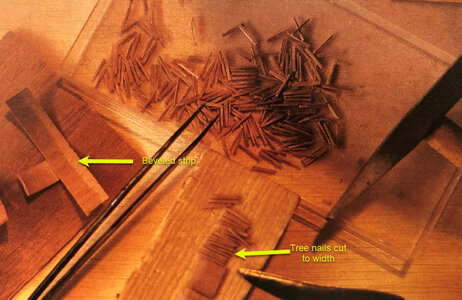
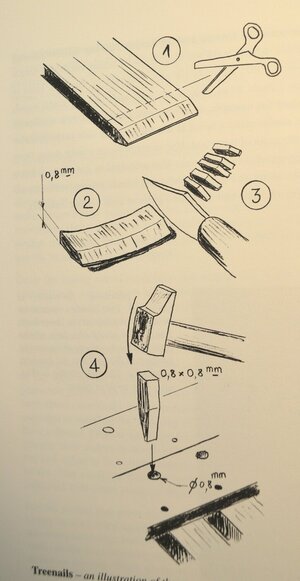
Bernard Frolich, in his book the art of Ship Modeling describes how he makes tree nails.
His example is for a 1/48 scale model: (He made 3000 tree nails per side for his model) Tedious, I guess.
- Drill .8mm holes
- Take a piece of close-grained hardwood, walnut for example, of 0.8 thickness. With two strokes of the sander make a bevel at the end on each side perpendicular to the grain of the wood.
- Use scissors to cut a strip parallel to the bevel.
- Use a scalpel to cut slices 0.8mm wide along the grain, producing small prisms with square upper sections and elongated pointed ends –our treenails.
- Lightly tap the tree nail into its hole. It will fit thanks to its shape, and the square edges will round off.
- Cut off the excess, tap in flush, file flat, and sand smooth.
- A coat of clear flat varnish will restore the contrast between the wood of the treenail and the surrounding pearwood.
- Joined
- Dec 1, 2016
- Messages
- 6,334
- Points
- 728

Dave, I hope you're not indicating I was offensive concerning someone's work. I am in fact in AWE of the work done here, and would never mean to say anything different. I am a newbie here, and would like to stay a while. Just trying to learn, and to find better ways of modeling.
oh no after reading my own post i do not think i got my point across so let me try to clarify
if modeling forums purpose is to teach and provide accurate information maybe we should not just say ya that looks great and let it go at that. In time even something that is not true becomes the truth if repeated enough times. Truth be known you would not see the nails in hull planking because hulls were painted and paint covered the nails. Iron spikes were use on decking counter sunk and plugged over.
something to ponder
the carpenters who build wooden ships belonged to the same tradesmen guild who built barns, buildings and houses. From early times to modern times there are age old methods that were used in post and beam construction. The main timbering in buildings and barns had certain types of joinery held together with wooden pegs the rest of the structure like the roof, barn siding, floors and internal structures all used nails and spikes, the same applied to wooden ships. The main structural timbering used joinery and wooden pegs everything else was spiked together.
it is difficult to reproduce in a 1:48 scale model iron spikes that would only be .013 thousanths in size.
now you have more historical information so more power to you
There is nothing right or wrong here because this is an art and you know what Salvador Dali said " art is whatever the artist says it is"
- Joined
- Jul 12, 2021
- Messages
- 137
- Points
- 143

Here is what I can offer about treenails, based on an apprenticeship as a wooden shipwright and forty years excavating and recording wooden ships from the Bronze Age up to the 20th century. Currently, I am responsible for Vasa, the Swedish warship of 1628.
1. Treenails were the most common method of attaching planks to frames from Viking times up to the 19th century in all of the northern European shipbuilding traditions, until iron production was sufficiently industrialized to make nails/spikes an affordable option. There are exceptions, but generally, nails were only used at the butts or tips of scarfs on all of the ships I have seen from before 1800. Deck planks could be attached by either nails or treenails. If nails are used, they may be countersunk and covered by wooden bungs, but not always. Nails vs treenails for deck planks does not seem to show any consistent pattern that I have seen - Vasa has the deck planks nailed down, without bungs, while the B71 ferry of about the same period and construction tradition has the deck planks fastened with treenails.
2. Planks are almost never fastened to frames or beams with a single treenail. They are almost always fastened with at least two treenails (or nails), one near each edge, and wider planks can have three or even four fasteners. There is a general tendency to stagger these fastenings, although the pattern is rarely absolutely regular, and I have seen plenty of cases where the treenails or other fastenings are in a line.
3. The smallest treenails I have seen for planks to frames are about 20 mm (3/4 inch), on boats in the range of 10-15 m (35-50 feet) long. The largest treenails I have seen are about 35 mm (1 3/8 inch) on big ships over 40 m (140 feet) long, but I have also seen treenails that size on 17th-century Dutch vessels less than 20 m (66 feet) long. 28-32 mm (1 1/8 to 1 1/4 inch) seems to be a very common size across a wide range of vessel sizes for ships built in oak from the Middle Ages onward.
4. Treenails have the end grain exposed, which tends to be darker than the surrounding long grain of the plank, even if of the same species, so in dry wood they can stand out, but what one sees is the difference in texture and color, not the outline of the edge. Once the wood gets wet, a lot of that difference disappears, and treenails become devilishly difficult to find, even when looking for them in full-sized timbers.
5. Bungs can be cut either with the end grain or the long grain exposed (I have seen both on real ships), but there is a general tendency to cut them with the long grain exposed, and an effort made to orient the grain of the bung with the grain of the surrounding plank. They effectively disappear.
6. Metal fastenings are iron, except in some very high-end state-built ships after 1650 or so, like HMS Victory, until copper alloy becomes a little more common on some merchant vessels in the 19th century for a few key fastenings. Even in Sweden, which produced most of the world's copper until the 18th century and where it was comparatively cheap, ships were fastened with iron (bronze costs about eight times what iron costs).
7. As was noted in a post above, interior furnishings are more likely to be held in place with nails than treenails or pegs. This does not include ceiling, as many of the main shipbuilding traditions in northern Europe tried to connect the ceiling, frames and planking with treenails which went through all three layers. This was especially typical of Dutch construction, in which the ceiling tends to be the same thickness as the planking and is a major strength member.
8. Some shipbuilders follow published specifications relatively closely, such as British and French naval yards run by the state, but many more do not. Merchant ships show a wide variation in practice, even within the same region, and I have looked at plenty of ships with variations within the same ship.
The bottom line is that reality is a lot messier than either contemporary treatises or modern modellers' handbooks would lead you to believe. And before someone says that "archaeology only shows us the ships that failed," I will note that a large number of the ships we have to look at are not wrecks, but ships which served long careers and were then abandoned or deliberately buried as cribbing. There is no difference that I can see in the fastening practice.
Fred Hocker
1. Treenails were the most common method of attaching planks to frames from Viking times up to the 19th century in all of the northern European shipbuilding traditions, until iron production was sufficiently industrialized to make nails/spikes an affordable option. There are exceptions, but generally, nails were only used at the butts or tips of scarfs on all of the ships I have seen from before 1800. Deck planks could be attached by either nails or treenails. If nails are used, they may be countersunk and covered by wooden bungs, but not always. Nails vs treenails for deck planks does not seem to show any consistent pattern that I have seen - Vasa has the deck planks nailed down, without bungs, while the B71 ferry of about the same period and construction tradition has the deck planks fastened with treenails.
2. Planks are almost never fastened to frames or beams with a single treenail. They are almost always fastened with at least two treenails (or nails), one near each edge, and wider planks can have three or even four fasteners. There is a general tendency to stagger these fastenings, although the pattern is rarely absolutely regular, and I have seen plenty of cases where the treenails or other fastenings are in a line.
3. The smallest treenails I have seen for planks to frames are about 20 mm (3/4 inch), on boats in the range of 10-15 m (35-50 feet) long. The largest treenails I have seen are about 35 mm (1 3/8 inch) on big ships over 40 m (140 feet) long, but I have also seen treenails that size on 17th-century Dutch vessels less than 20 m (66 feet) long. 28-32 mm (1 1/8 to 1 1/4 inch) seems to be a very common size across a wide range of vessel sizes for ships built in oak from the Middle Ages onward.
4. Treenails have the end grain exposed, which tends to be darker than the surrounding long grain of the plank, even if of the same species, so in dry wood they can stand out, but what one sees is the difference in texture and color, not the outline of the edge. Once the wood gets wet, a lot of that difference disappears, and treenails become devilishly difficult to find, even when looking for them in full-sized timbers.
5. Bungs can be cut either with the end grain or the long grain exposed (I have seen both on real ships), but there is a general tendency to cut them with the long grain exposed, and an effort made to orient the grain of the bung with the grain of the surrounding plank. They effectively disappear.
6. Metal fastenings are iron, except in some very high-end state-built ships after 1650 or so, like HMS Victory, until copper alloy becomes a little more common on some merchant vessels in the 19th century for a few key fastenings. Even in Sweden, which produced most of the world's copper until the 18th century and where it was comparatively cheap, ships were fastened with iron (bronze costs about eight times what iron costs).
7. As was noted in a post above, interior furnishings are more likely to be held in place with nails than treenails or pegs. This does not include ceiling, as many of the main shipbuilding traditions in northern Europe tried to connect the ceiling, frames and planking with treenails which went through all three layers. This was especially typical of Dutch construction, in which the ceiling tends to be the same thickness as the planking and is a major strength member.
8. Some shipbuilders follow published specifications relatively closely, such as British and French naval yards run by the state, but many more do not. Merchant ships show a wide variation in practice, even within the same region, and I have looked at plenty of ships with variations within the same ship.
The bottom line is that reality is a lot messier than either contemporary treatises or modern modellers' handbooks would lead you to believe. And before someone says that "archaeology only shows us the ships that failed," I will note that a large number of the ships we have to look at are not wrecks, but ships which served long careers and were then abandoned or deliberately buried as cribbing. There is no difference that I can see in the fastening practice.
Fred Hocker
Wonderful information, Fred. Thanks so much! And if I say I'm envious of you being able to spend time with the Vasa, that would be an understatement.
As to the copper frame fastenings, about what diameter would you say those were on a Bonhomme Richard size ship? And I've always wondered about the use of copper rather than brass or bronze, both of which are stronger and harder than copper. Is the softness of copper more desired for these fasteners? I wouldn't have thought so, since later they were replaced with iron.
As to the copper frame fastenings, about what diameter would you say those were on a Bonhomme Richard size ship? And I've always wondered about the use of copper rather than brass or bronze, both of which are stronger and harder than copper. Is the softness of copper more desired for these fasteners? I wouldn't have thought so, since later they were replaced with iron.
A really interesting and informative post Fred. The information you have provided has made my decision easier regarding my need to treenail a 1:64 scale model or not. In particular the selective parts I copied from your post above. Thanks.Here is what I can offer about treenails, based on an apprenticeship as a wooden shipwright and forty years excavating and recording wooden ships from the Bronze Age up to the 20th century. Currently, I am responsible for Vasa, the Swedish warship of 1628.
3. The smallest treenails I have seen for planks to frames are about 20 mm (3/4 inch), on boats in the range of 10-15 m (35-50 feet) long. The largest treenails I have seen are about 35 mm (1 3/8 inch) on big ships over 40 m (140 feet) long, but I have also seen treenails that size on 17th-century Dutch vessels less than 20 m (66 feet) long. 28-32 mm (1 1/8 to 1 1/4 inch) seems to be a very common size across a wide range of vessel sizes for ships built in oak from the Middle Ages onward.
4. Treenails have the end grain exposed, which tends to be darker than the surrounding long grain of the plank, even if of the same species, so in dry wood they can stand out, but what one sees is the difference in texture and color, not the outline of the edge. Once the wood gets wet, a lot of that difference disappears, and treenails become devilishly difficult to find, even when looking for them in full-sized timbers.
Fred Hocker
- Joined
- Dec 1, 2016
- Messages
- 6,334
- Points
- 728

thank you Fred for the post
it seems iron and or wooden pegs were a random thing.
i was confused about treenails when i was told decking used wooden pegs and i saw spikes in wrecks. Then tree nails were only used in early ship building and i came across timbers of a wooden ship dated 1876 and it had wooden pegs.
Here is some information from shipyard records from the naval yard in Philly PA dated 1780 to 1800ish
The British yard at Amherstburg inventory had lots of spikes and nails, William Bell mentioned he burned an old ship for the iron spikes.
now i do not know what a "bolt" is might be just a rod or threaded rod? i do not know
threaded nuts and bolts were used in the shipyard by 1836 because the Mississippi used them and i have drawings of the bolts.
so far no where is there mention of wooden treenails or wooden pegs in the information i have.
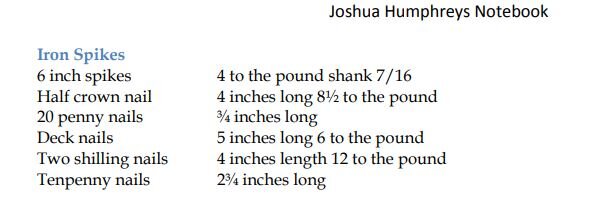
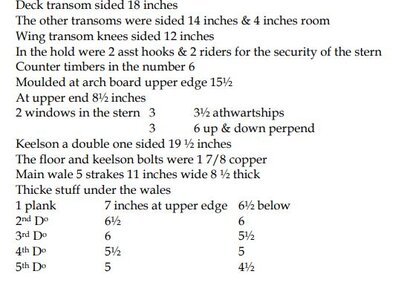
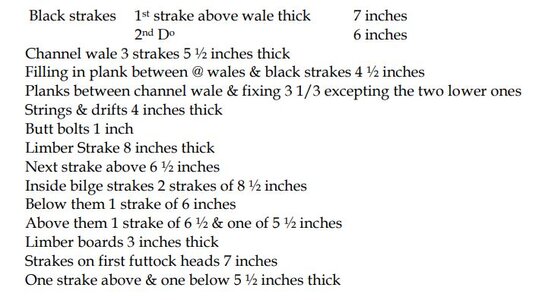


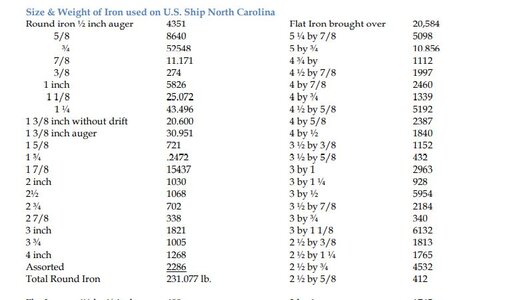

it seems iron and or wooden pegs were a random thing.
i was confused about treenails when i was told decking used wooden pegs and i saw spikes in wrecks. Then tree nails were only used in early ship building and i came across timbers of a wooden ship dated 1876 and it had wooden pegs.
Here is some information from shipyard records from the naval yard in Philly PA dated 1780 to 1800ish
The British yard at Amherstburg inventory had lots of spikes and nails, William Bell mentioned he burned an old ship for the iron spikes.
now i do not know what a "bolt" is might be just a rod or threaded rod? i do not know
threaded nuts and bolts were used in the shipyard by 1836 because the Mississippi used them and i have drawings of the bolts.
so far no where is there mention of wooden treenails or wooden pegs in the information i have.







Last edited:
My approach, depending on scale, I have duplicated the use of fasteners in planking with a sewing needle. I lay down shallow pin pricks with the needle and then when I apply a coating of matte or satin poly it brings out a contrast to the pin prick that is discernible but very small and subtle. I do not try to drill holes and fill with a treenail materiel as I can not make such an option small enough to make sense. The last few models I have dispensed with trying to make discernible fastener marks. I do admit that seeing fastener marks done on a model has a certain appeal that is attractive and eye catching!
More interesting information. Your mention of threaded rod and nuts and bolts caught my eye. About five years ago a friend of mine found some flotsam locally. He and I and a naval architect friend puzzled over the parts. Initially we believed the main piece to be a knee. We never came up with a definitive answer as to what part of a wreck these were from but possibly the fittings will be interesting and supplement this expanding discussion.thank you Fred for the post
it seems iron and or wooden pegs were a random thing.
i was confused about treenails when i was told decking used wooden pegs and i saw spikes in wrecks. Then tree nails were only used in early ship building and i came across timbers of a wooden ship dated 1876 and it had wooden pegs.
Here is some information from shipyard records from the naval yard in Philly PA dated 1780 to 1800ish
The British yard at Amherstburg inventory had lots of spikes and nails, William Bell mentioned he burned an old ship for the iron spikes.
now i do not know what a "bolt" is might be just a rod or threaded rod? i do not know
threaded nuts and bolts were used in the shipyard by 1836 because the Mississippi used them and i have drawings of the bolts.
so far no where is there mention of wooden treenails or wooden pegs in the information i have.
View attachment 276462View attachment 276463View attachment 276464View attachment 276465View attachment 276466View attachment 276467View attachment 276468
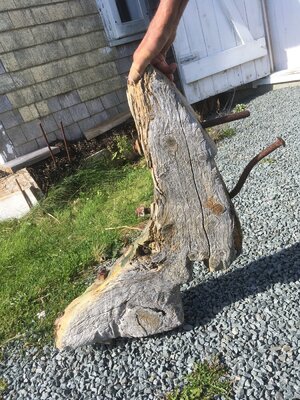
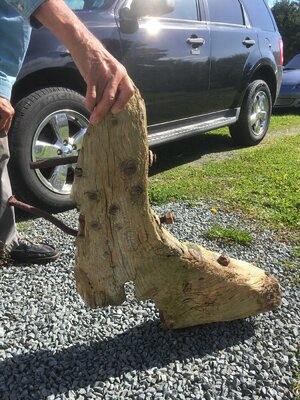
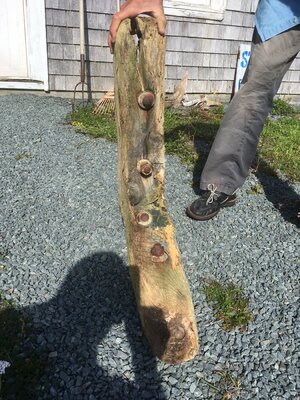
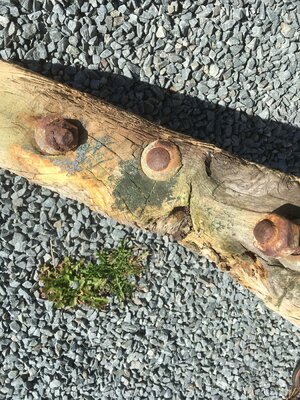
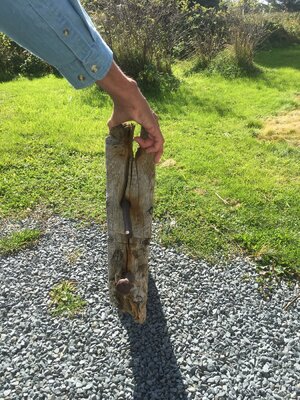
- Joined
- Oct 9, 2020
- Messages
- 2,191
- Points
- 488

it does give a nice effect.I have used 1x1 stock and draw them thru a plate. Drill the holes as needed and place the treenail in place and cut at the deck surface. Sand sooth. This method does take some time but turns out very well.View attachment 275789View attachment 275790View attachment 275791View attachment 275792View attachment 275793
- Joined
- Oct 9, 2020
- Messages
- 2,191
- Points
- 488

part of the rudder?More interesting information. Your mention of threaded rod and nuts and bolts caught my eye. About five years ago a friend of mine found some flotsam locally. He and I and a naval architect friend puzzled over the parts. Initially we believed the main piece to be a knee. We never came up with a definitive answer as to what part of a wreck these were from but possibly the fittings will be interesting and supplement this expanding discussion.
View attachment 276470View attachment 276471View attachment 276472View attachment 276473View attachment 276474
- Joined
- Oct 9, 2020
- Messages
- 2,191
- Points
- 488

i agree. there is my dilemma. I love the look but the trunnels wind up being too big for the scale. For this reason I don't bother with trunnels.My approach, depending on scale, I have duplicated the use of fasteners in planking with a sewing needle. I lay down shallow pin pricks with the needle and then when I apply a coating of matte or satin poly it brings out a contrast to the pin prick that is discernible but very small and subtle. I do not try to drill holes and fill with a treenail materiel as I can not make such an option small enough to make sense. The last few models I have dispensed with trying to make discernible fastener marks. I do admit that seeing fastener marks done on a model has a certain appeal that is attractive and eye catching!
I have it in my head it’s a beam knee but not sure.part of the rudder?
- Joined
- Jul 12, 2021
- Messages
- 137
- Points
- 143

This is great data! In wooden shipbuilding of this period, "bolt" means a metal fastener of constant section (spikes and nails are tapered). They are essentially big rivets, peened on each end, or made with a head on one end and the other end peened over after driving through the timbers. Bolts were mostly used for attaching the deck structure and its reinforcements (knees, standards, riders) to the main hull structure of planks, frames and ceiling, although I have also seen bolts used through the clamps and wales (the English Sea Venture of 1609 was built this way) or through the bilge stringers.thank you Fred for the post
it seems iron and or wooden pegs were a random thing.
i was confused about treenails when i was told decking used wooden pegs and i saw spikes in wrecks. Then tree nails were only used in early ship building and i came across timbers of a wooden ship dated 1876 and it had wooden pegs.
Here is some information from shipyard records from the naval yard in Philly PA dated 1780 to 1800ish
The British yard at Amherstburg inventory had lots of spikes and nails, William Bell mentioned he burned an old ship for the iron spikes.
now i do not know what a "bolt" is might be just a rod or threaded rod? i do not know
threaded nuts and bolts were used in the shipyard by 1836 because the Mississippi used them and i have drawings of the bolts.
so far no where is there mention of wooden treenails or wooden pegs in the information i have.
View attachment 276462View attachment 276463View attachment 276464View attachment 276465View attachment 276466View attachment 276467View attachment 276468
Fred

